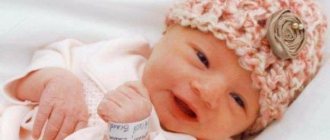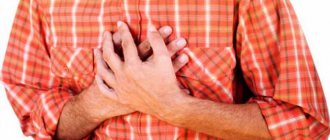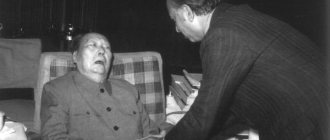Niemann-Pick disease is a hereditary disease that is characterized by an increase in size and dysfunction of the liver and spleen, and in some cases, the development of mental disorders - epilepsy, dementia, developmental delays in children. The cause of these phenomena is the accumulation of fats in tissues with the gradual transformation of cells into a storage of sphingomyelin and cholesterol.
Scientists distinguish 4 types of Niemann-Pick disease, which are designated by the first letters of the Latin alphabet - A, B, C and D. Each of them is caused by various defects in the 11, 14 or 18 pairs of chromosomes. Type A is considered the most dangerous and malignant. It is diagnosed in the first months of life and without effective treatment, babies rarely manage to live more than two years.
Symptoms
The clinical picture of Niemann-Pick disease can be different, which led to its division into types. In more than 70% of cases, the pathology occurs as type B. In this case, the first symptom in infants is jaundice in the first months of life. By 2-3 years, a slight increase in the size of the liver and spleen and digestive disorders are recorded. At 6-8 years old, children often complain of abdominal pain, nausea and vomiting. Disruption of the spleen quickly affects the formation of platelets - in children with Niemann-Pick syndrome, blood clotting is impaired.
In the absence of effective treatment methods, fatty compounds begin to be deposited in the lungs. By adolescence, the patient’s chart shows frequent notes about bronchitis and pneumonia, and there are frequent cases of ascites - a sharp enlargement of the abdomen associated with disruption of the portal vein.
In type C, Niemann-Pick disease is also accompanied by disorders of the nervous system: children are developmentally delayed and often suffer from epileptic seizures and dementia. Symptoms of cirrhosis of the liver and obesity of the spleen progress so quickly that by the age of five a complex operation to remove their lobes may be required. Every year, treatment of Niemann-Pick disease abroad becomes more of a vital necessity, regardless of the cost and the need for flights.
Etiology of the development of Niemann-Pick pathology
The main reason for the development of Niemann-Pick pathology is a defect in chromosomes:
- On chromosome No. 11 (pathology type A);
- On chromosomes No. 14 and No. 18 (pathology type B).
When there is a violation or defect in the chromosomes, there is a decrease in the activity of sphingomyelinase molecules, which breaks down sphingomyelin fat molecules.
With such a disturbance in activity, sphingomyelin fat molecules accumulate together with cholesterol molecules in macrophages, which leads to disruption of lipid metabolism, as well as to the metabolism of the entire body.
Provoking factors that can aggravate the progression of Niemann-Pick disease:
- Poor nutrition with a predominance of animal fats in the diet;
- Alcohol abuse;
- Physical inactivity and complete absence of stress on the body;
- Overweight - obesity;
- Constant overstrain of the nervous system;
- Frequent stressful situations;
- Chronic pathologies in the body.
If several genes are mutated simultaneously, then Niemann-Pick disease occurs in a complicated form.
When there is a violation or defect in the chromosomes, the activity of sphingomyelinase molecules decreases
Diagnosis of the disease
As a rule, typical symptoms of the disease can be noticed already in the first months of the baby’s life. Enlarged liver and spleen, indifference to the environment and lethargy are the first signs of pathology, when detected, the child is sent for tests to a genetics center. Nowadays a whole range of techniques is used that allows not only to establish a diagnosis, but also to determine the type of disease and make predictions.
- In skin cell culture, defects in 11, 14 or 18 pairs of genes are detected;
- analyze the activity of sphingomyelinase in a culture of leukocytes;
- The most accurate results are obtained from a bone marrow biopsy, which reveals characteristic “foam” cells.
Treatment of Niemann-Pick disease abroad does not begin without additional diagnostics necessary to determine the extent of anatomical changes in organs and tissues. A computed tomography scan of the brain, an ultrasound scan of the abdominal cavity, and psychiatric tests are required.
Symptoms of Niemann-Pick disease
- usually occurs in infancy;
- central hypotension;
- delay or cessation of speech development;
- gait disturbance;
- dysmetria;
- diadochokinesis;
- dysarthria;
- dysphagia;
- saccadic eye movements;
- cataplexy;
- narcolepsy;
- obstructive sleep apnea;
- epileptic seizures;
- sensorineural hearing loss;
- peripheral neuropathy;
- decreased cognitive function;
- catatonia;
- behavioral deviations;
- auditory hallucinations;
- visual hallucinations;
- delusional ideas;
- depression;
- ascites;
- neonatal cholestasis;
- jaundice;
- hepatosplenomegaly.
Treatment of pathology in Germany
For many years, only a number of medications were used to treat Niemann-Pick disease to alleviate the symptoms of the disease. In chronic cases of types B and C, this approach made it possible to significantly improve the patient’s quality of life and prolong his life.
Today, treatment of Niemann-Pick disease in Germany is based on the latest advances in medicine and genetics. Drugs that block the synthesis of sphingomyelin, the accumulation of which is the cause of enlargement of internal organs and mental disorders, are widely used. Their use is indicated for patients throughout their lives.
High results are achieved by bone marrow transplantation, in which stem cells with a defective genotype are replaced with healthy ones.
The timing of a transplant is determined not so much by the price as by the time it takes to find a suitable donor. Having healthy relatives with a suitable set of immunoglobulins simplifies the task. If the organs are significantly enlarged, surgery is performed to remove the spleen and resection of the liver.
Prices for Niemann-Pick disease treatment in Germany vary depending on the number of procedures and surgeries required. A benign course of type B extremely rarely requires a surgical solution, while type A requires urgent qualified intervention.
Heredity and genetics
Alzheimer's syndrome is one of the types of senile dementia, and the most common.
Statistics show that more than 50% of elderly people are susceptible to this disease to one degree or another. Is Alzheimer's disease inherited?
Geneticists have been able to establish through research that there is indeed some dependence on hereditary factors: the likelihood of developing senile dementia of the Alzheimer's type increases significantly if one of the close relatives has been affected by this disease.
In the case where dementia affects not one, but two family members, this fact should seriously alert the younger generation: the probability doubles, as evidenced by statistical data.
Editor's note: What is attention deficit disorder in adults?
These data allow scientists to claim that this disease is hereditary in nature, that is, it is genetically determined.
The disease affects brain cells, the volume of which decreases, which is visible to the naked eye according to the results of CT and MRI studies.
Alzheimer's syndrome is not infectious, which excludes the possibility of infection. It is impossible to become infected with this disease: it is not the disease that is transmitted, but a predisposition to it.
The mechanism of the occurrence of dementia is not fully understood; there are many theories about what exactly serves as an impetus for the body.
The discovery of symptoms similar to the manifestations of this particular disease does not give reason to make such a diagnosis for yourself, even if several ancestors suffered from dementia.
You can find a test on the Internet and answer questions - it’s interesting and educational, but it does not answer the question of whether Alzheimer’s disease has begun to progress.
Only specialists, after conducting a series of tests and studies, will be able to make an accurate diagnosis, because the manifestations of this disease only indicate memory problems, and similar symptoms are observed in other diseases.
For example, atherosclerosis also leads to the development of senile dementia, but it is still a completely different disease that requires different preventive and medicinal measures.
Heredity, age, gender as causes of Alzheimer's disease:
DMU: comprehensive treatment support in Germany
Severe syndromes and a threat to the life of a child with Niemann-Pick disease dictate their conditions to parents - treatment must be provided regardless of its price, with high quality and without delay. If at the same time you are stopped by a difficult choice and search for a clinic, lack of language knowledge, fear of flying, the need for accommodation in a foreign country and the difficulty of obtaining visas, our specialists are ready to help and take responsibility for all organizational issues. After all, Niemann-Pick disease in Germany is considered and treated comprehensively, which makes it possible to compensate for the pathology at any age.
Specialists from the DMU center in Russia will be by your side throughout the entire treatment cycle:
- we will select the best specialists in Germany for you, provide an estimate, treatment plan and schedule a visit;
- We will help you with obtaining a medical visa;
- we will book tickets and accompany you from departure to return home;
- There will be a professional translator next to you who will explain everything the doctor says.
You can be sure that the prices for each service are justified. Our coordinators carefully check the invoices issued and compare them with the price list recommended by the German Ministry of Health. Treatment abroad can be your ticket to a new life, and we are ready to support you in every action.
Treatment of Niemann-Pick disease
The goal of the therapy is to correct neurological and mental disorders to improve the quality of life of patients with BNP. For this purpose, symptomatic and pathogenetic agents are prescribed. Anticonvulsants, atypical neuroleptics, mood stabilizers, antibacterial drugs, and cognitive enhancement drugs are widely used. Electroconvulsive therapy has been successfully used for catatonia. Pathogenetic therapy is carried out with the drug miglustat (Zaveska), which acts as a competitive inhibitor of the enzyme glucosirceramide synthase, which catalyzes the first fixed stage of glycosphingolipid synthesis. The recommended dose of miglustat for adults and adolescents is 200 mg three times daily. The dose in patients aged 4-12 years is determined based on body surface area. At the same time, a strict diet with restriction of disaccharides is prescribed. A common complication of miglustat use is diarrhea, which requires the use of antidiarrheal drugs and probiotics. The effect of using the drug occurs no earlier than six months later, and often much later, but the prognosis is significantly improved.
Essential drugs
There are contraindications. Specialist consultation is required.
- Miglustat (Zavesca) is a glucosylceramide synthase inhibitor. Dosage regimen: taken orally, regardless of food intake, at a dose of 200 mg 3 times a day. for adults and children over 12 years old. The dose for young children is determined based on body surface area. If diarrhea or renal failure develops, the dose of the drug is reduced.










